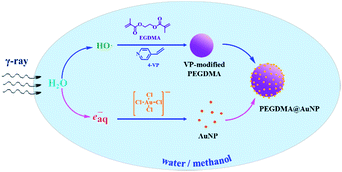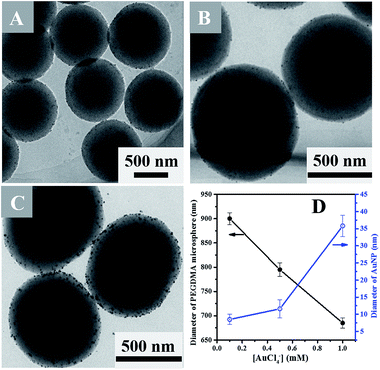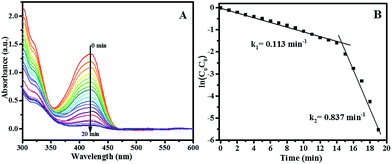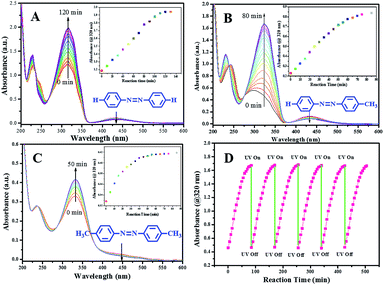One-step synthesis of poly(ethyleneglycol dimethacrylate)-microspheres-supported nano-Au catalyst in methanol–water solution under γ-ray radiation†
Jinxing Chena,
Feng Chena,
Yiyao Wanga,
Mozhen Wang*a,
Qichao Wub,
Xiao Zhoub and
Xuewu Ge*a
aCAS Key Laboratory of Soft Matter Chemistry, Department of Polymer Science and Engineering, University of Science and Technology of China, Hefei, Anhui 230026, P. R. China. E-mail: pstwmz@ustc.edu.cn; xwge@ustc.edu.cn; Tel: +86-551-63600843
bGuangdong Tian'an New Material Co., Ltd., Foshan, Guangdong 528000, P. R. China
First published on 30th May 2016
Abstract
A sub-micron sized highly-crosslinked poly(ethyleneglycol dimethacrylate) (PEGDMA) microsphere supported nano-Au catalyst (PEGDMA@AuNP) was successfully prepared through a one-step synthesis method at room temperature and ambient pressure, taking advantage of the γ-ray radiation effect on a simple one-pot system, i.e. a methanol–water solution containing EGDMA, 4-VP, and HAuCl4. Electron microscopy, XPS, and XRD analyses proved that AuNPs of several nanometers had been synthesized and loaded simultaneously with the formation of crosslinked PEGDMA microspheres when the adsorbed dose rate and the initial concentration of HAuCl4 were controlled within a narrow range, i.e. 35–80 Gy min−1 and below 1 mmol L−1 of [HAuCl4]. The size of the prepared PEGDMA@AuNP microspheres changed little with the dose rate, but decreased with the initial [HAuCl4], from 900 nm at 0.1 mmol L−1 to 680 nm at 1 mmol L−1. At the same time, the size of AuNPs increases with the initial [HAuCl4], from 8 nm at 0.1 mmol L−1 to 35 nm at 1 mmol L−1. The prepared PEGDMA@AuNP microspheres can be dispersed stably in both water and organic solvent, CH3CN. They exhibit excellent catalytic efficiency not only on the reduction of Fe(CN)63− by NaBH4 in aqueous solution, but also on the cis–trans isomerization of azobenzenes in CH3CN at room temperature. A satisfactory repeatability of the catalytic performance of the prepared PEGDMA@AuNP microspheres was achieved in organic solvents. This work opens a new green simple and economic way to the synthesis of efficient and chemically-stable polymer-supported nano-metal catalysts.
Introduction
Noble metal nanoparticles have attracted much attention in the research area of catalysts owing to their large specific surface area, high selectivity and catalytic performance.1,2 However, these nanoparticles have a strong tendency to agglomerate, which dramatically weakens their catalytic performance.3 Meanwhile, people have always been exploring the recycling of noble metal nanocatalysts in order to save the cost of the catalyst and increase the purity of products. Therefore, intense efforts have been devoted to develop various carriers to load the metal nanoparticles, which can prevent the agglomeration of the nanoparticles,4–7 and on the other hand, can be helpful for the separation of the catalyst.8,9 Polymer microspheres have been widely studied to load the metal nanoparticles due to their several special advantages compared with inorganic matrices, such as easy morphological control and diverse surface functionalization.10–13 Nevertheless, polymeric carriers have a critical shortcoming, i.e. most of non- or lightly-crosslinked polymer materials can be swollen, and even dissolved in organic solvents, resulting in the loss of the carrier function. Therefore, the fabrication of highly crosslinked polymer microspheres should be developed for the fabrication of the carriers with good chemical durability.The highly-crosslinked poly(ethyleneglycol dimethacrylate) (PEGDMA) microspheres has the potential for loading metal nanoparticles since they contain carbonyl groups which are proved to have the ability to chelate metal ions.14,15 However, up to now, the pure highly-crosslinked PEGDMA microspheres have been found to be synthesized by precipitation polymerization only in some organic solvents, such as acetonitrile,16 ethyl acetate,17 and acetic acid.18 Recently, we have successfully achieved a solvothermal precipitation polymerization of ethyleneglycol dimethacrylate (EGDMA) and a small amount of 4-vinylpyridine (4-VP) in a common methanol–water or ethanol–water solution, and obtained highly-crosslinked PEGDMA microspheres with surfaces modified by pyridine groups at a yield above 90%.19 Evidently, the pyridine moieties will further improve the affinity of metal ions or nanoparticles and the PEGDMA microspheres.20 But all the current preparation conditions of PEGDMA microspheres cannot be compatible with the synthesis of metal nanoparticles, which makes the supporting of metal nanoparticles on PEGDMA microspheres not be realized in a one-pot synthesis process. Therefore, the exploration of a new one-pot strategy for the one-step synthesis of PEGDMA-microspheres-supported metal nanoparticles is very meaningful because it can greatly simplify the preparation process and save the cost.
In this work, we reported a green one-step synthesis on the highly-crosslinked PEGDMA microspheres supported Au nanoparticles (PEGDMA@AuNP) through γ-ray radiation on a simple one-pot system, i.e. a methanol–water solution containing EGDMA, 4-VP, and HAuCl4, at room temperature and ambient pressure. The prepared PEGDMA@AuNP can be dispersed stably and exhibit excellent catalytic efficiency in both aqueous solution and organic solvent.
Experimental
Materials
4-Vinylpyridine (4-VP, 99%, TCI Development Co., Ltd.) and ethyleneglycol dimethacrylate (EGDMA, 98%, Sigma Aldrich) were purified by passing through the basic aluminum oxide column before use. Three kinds of trans-azobenzenes including azobenzene, 4-methylazobenzene, 4,4′-dimethylazobenzene were purchased from the Aladdin Industrial Corporation. All other analytical grade reagents, including chloroauric acid tetrahydrate (HAuCl4·4H2O), potassium ferricyanide (K3[Fe(CN)6]), sodium borohydride (NaBH4), acetonitrile (CH3CN), and methanol were all purchased from Sinopharm Chemical Reagent Co. Ltd. Deionized water was utilized in all experiments.Method
![[thin space (1/6-em)]](https://www.rsc.org/images/entities/char_2009.gif) :
:![[thin space (1/6-em)]](https://www.rsc.org/images/entities/char_2009.gif) 1. Then, a certain volume (0.5–5 mL) of HAuCl4 solution (5 mmol L−1) was mixed homogeneously with the above monomer solution under gently stirring. After being purged with nitrogen for 10 min at a flowing rate of 60 bubbles per min, the system was sealed and exposed under the irradiation of 60Co γ-ray (located at USTC, 1.25 × 1015 Bq) at a certain absorbed dose rate. The dose rate was calibrated with the Fricke dosimeter. The total absorbed dose was fixed to be 15 kGy. The final product was separated from the radiated dispersion by centrifugation at 7000 rpm, then washed with ethanol thrice, and dried in a vacuum oven at 50 °C for 12 h.
1. Then, a certain volume (0.5–5 mL) of HAuCl4 solution (5 mmol L−1) was mixed homogeneously with the above monomer solution under gently stirring. After being purged with nitrogen for 10 min at a flowing rate of 60 bubbles per min, the system was sealed and exposed under the irradiation of 60Co γ-ray (located at USTC, 1.25 × 1015 Bq) at a certain absorbed dose rate. The dose rate was calibrated with the Fricke dosimeter. The total absorbed dose was fixed to be 15 kGy. The final product was separated from the radiated dispersion by centrifugation at 7000 rpm, then washed with ethanol thrice, and dried in a vacuum oven at 50 °C for 12 h.Characterization
The morphologies of the prepared polymer microspheres and AuNP were observed by scanning electron microscopy (SEM, JEOL JSM6700F, 5.0 kV) and high resolution transmission electron microscopy (HRTEM, JEM-2010, 200 kV). The number-average diameter (Dn), weight-average diameter (Dw), and polydispersity index (PDI) of the microspheres were calculated by the following equations with the diameters of at least 100 particles measured in the SEM images:
 | (1) |
 | (2) |
| PDI = Dw/Dn | (3) |
X-ray photoelectron spectroscopy (XPS) was carried out on Thermo ESCALAB 250 using monochromatic Al Kα radiation. X-ray diffraction (XRD) was performed with a Rigaku SmartLab high resolution X-ray diffraction system using Cu Kα radiation at a wavelength of 0.1541 nm at room temperature.
Results and discussion
One-step synthesis of highly-crosslinked PEGDMA microspheres supported Au nanoparticles by γ-ray radiation
It is well-known that water will be decomposed to form transient reactive radicals and molecular products under γ-ray radiation, as shown in eqn (4),22
 | (4) |
The hydrated electrons (eaq−) and H· atoms are strong reducing species to reduce metal ions to zero valent metal atoms, and finally to form metal nanoparticles in the aqueous solutions at the presence of radical scavengers for oxidative ·OH, such as secondary alcohols and formate anions.23–25 On the other hand, ·OH radicals can easily induce the polymerization of various vinyl monomers dispersed in aqueous system.26–28 That means monomers can serve as radical scavenger in a sense. Therefore, the formation of metal nanoparticles induced by eaq− can possibly be achieved at the same time with the polymerization of monomers induced by ·OH radicals in an aqueous system. However, the successful preparation of highly-crosslinked PEGDMA microspheres from an alcohol–water solution at room temperature and ambient pressure has never been reported. Therefore, a novel one-step synthesis process of highly-crosslinked PEGDMA microspheres supported Au nanoparticles (PEGDMA@AuNP) is designed to be operated in an aqueous system at room temperature under γ-ray radiation, as illustrated in Scheme 1, according to our previous work on the solvothermal precipitation polymerization of EGDMA and 4-VP in alcohol–water solution.19 A methanol–water mixture with a volume ratio of 4![[thin space (1/6-em)]](https://www.rsc.org/images/entities/char_2009.gif) :
:![[thin space (1/6-em)]](https://www.rsc.org/images/entities/char_2009.gif) 1 was chosen as the solvent, and a small amount of hydrophilic 4-VP (the molar ratio of EGDMA and 4-VP was 4.5
1 was chosen as the solvent, and a small amount of hydrophilic 4-VP (the molar ratio of EGDMA and 4-VP was 4.5![[thin space (1/6-em)]](https://www.rsc.org/images/entities/char_2009.gif) :
:![[thin space (1/6-em)]](https://www.rsc.org/images/entities/char_2009.gif) 1) was adopted for the stabilization of PEGDMA microspheres and the chelation of the in situ formed Au nanoparticles.
1) was adopted for the stabilization of PEGDMA microspheres and the chelation of the in situ formed Au nanoparticles.
In a high energy radiation induced polymerization system, the dose rate plays the crucial role in the rate and degree of polymerization, which have a great influence on for the formation of stable polymer nuclei and the final microspheres in the case of precipitation polymerization of crosslinking monomers.29 Thus, the dependence of the morphology of PEGDMA@AuNP microspheres on the dose rate was investigated. The results show that when the system was irradiated at a dose rate less than 35 Gy min−1 or above 80 Gy min−1, only massive aggregates could be obtained (Fig. S2†). However, stable individual PEGDMA@AuNP microspheres were indeed formed successfully at a dose rate ranging from 35 to 80 Gy min−1, as shown in Fig. 1. Referring to the previous study on the solvothermal precipitation polymerization of EGDMA and 4-VP in alcohol–water solution,19 it can be deduced that the dose rate plays a key role on the formation of stable initial spherical nuclei through controlling the copolymerization process of EGDMA and 4-VP.
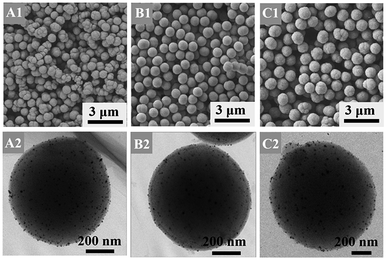 | ||
| Fig. 1 SEM and HRTEM images of PEGDMA@AuNP microspheres prepared at different dose rate: 35 Gy min−1 (A1, A2), 55 Gy min−1 (B1, B2), and 80 Gy min−1 (C1, C2). | ||
When the system is irradiated at a low dose rate, the polymerization of 4-VP is too slow due to the low concentration of produced free radicals and 4-VP itself so that the primary nuclei mainly composed of PEGDMA oligomers couldn't be stabilized, resulting in the massive floccules (Fig. S2A†). In turn, if the system is irradiated at a much higher dose rate, the copolymerization rate of EGDMA and 4-VP will become too fast to be controlled, also producing a crosslinked monolith product (Fig. S2B†). Only when the system is irradiated at a moderate dose rate, the primary formed oligomers can contain a certain amount of P4VP segments, which can stable the hydrophobic PEGDMA nuclei. The optimum dose rate is ca. 55 Gy min−1 from Fig. 1 since monodispersed PEGDMA@AuNP microspheres with an average diameter of 820 nm are prepared with nearly no aggregates. It is clearly seen in Fig. 1A and C that the products obtained at either higher or lower dose rate are mainly aggregates of small particles, although they are also individual microspheres, indicating an unstable nucleation process.
The HRTEM images in Fig. 1 clearly exhibit that nanoparticles with an average diameter of 8–10 nm are uniformly distributed around the surface of PEGDMA microspheres. The typical XPS spectrum of the prepared PEGDMA@AuNP microspheres detects the existence of Au element in addition to C, N, and O, as shown in Fig. 2A. From the magnified peaks in Fig. 2A, the binding energy of Au0 (84.2 and 87.8 eV respectively for Au4f7/2 and Au4f5/2) can be clearly distinguished, as well as those of C–C (284.7 eV), C–O (286.4 eV), and C![[double bond, length as m-dash]](https://www.rsc.org/images/entities/char_e001.gif) O (288.4 eV) attributed to EGDMA units and the N1s (400.2 and 398.9 eV) for N atoms coordinated with Au species and neutral N atoms of the pyridine ring.20 The XRD spectrum of PEGDMA@AuNP microspheres in Fig. 2B exhibits four diffraction peaks located at 38.1°, 44.3°, 64.6°, and 77.6°, which are attributed to (111), (200), (220), and (311) crystalline plane,30 according to the Au standard card (JCPDS no. 040784). Furthermore, the HRTEM image with a higher magnification was measured, as shown in Fig. 2C, which clearly shows the multiple lattice fringes with an interplanar spacing of 0.227 nm, consistent with the interplanar distance of the Au0 (111) plane.31 All the above results indicate that Au nanoparticles have been synthesized and loaded simultaneously during the formation of PEGDMA microspheres. It has been reported that in the radiolysis of methanol, the addition of mineral acid will increase the yield of active H· through the interaction between secondary electrons from the radiolysis and the H+ from the acid, as expressed by the following eqn (5):32
O (288.4 eV) attributed to EGDMA units and the N1s (400.2 and 398.9 eV) for N atoms coordinated with Au species and neutral N atoms of the pyridine ring.20 The XRD spectrum of PEGDMA@AuNP microspheres in Fig. 2B exhibits four diffraction peaks located at 38.1°, 44.3°, 64.6°, and 77.6°, which are attributed to (111), (200), (220), and (311) crystalline plane,30 according to the Au standard card (JCPDS no. 040784). Furthermore, the HRTEM image with a higher magnification was measured, as shown in Fig. 2C, which clearly shows the multiple lattice fringes with an interplanar spacing of 0.227 nm, consistent with the interplanar distance of the Au0 (111) plane.31 All the above results indicate that Au nanoparticles have been synthesized and loaded simultaneously during the formation of PEGDMA microspheres. It has been reported that in the radiolysis of methanol, the addition of mineral acid will increase the yield of active H· through the interaction between secondary electrons from the radiolysis and the H+ from the acid, as expressed by the following eqn (5):32
| CH3OH2+ + e− → CH3OH + H | (5) |
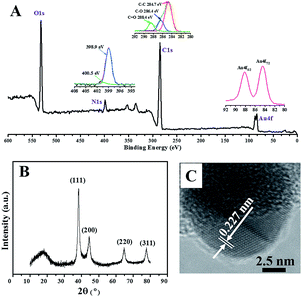 | ||
| Fig. 2 XPS (A), XRD (B) and the magnified HRTEM image of multiple lattice fringes (C) of PEGDMA@AuNP microspheres prepared at a dose rate of 55 Gy min−1 and an initial [AuCl4−] of 0.5 mmol L−1. | ||
The active reductive H· can induce both the polymerization of monomers and the reduction of Au(III). Thus, the effect of the initial concentration of HAuCl4 on the morphology of PEGDMA@AuNP at a fixed monomer concentration was investigated since HAuCl4 will be ionized in water so as to increase [H+] in the solvent. As clearly shown in Fig. 3A–C, HAuCl4 won't disturb the formation of monodispersed PEGDMA@AuNP microspheres at an initial [AuCl4−] of 0.1–1 mmol L−1, but has great influence on the sizes of both PEGDMA microspheres and AuNP, as exhibited in Fig. 3D. The average diameter of PEGDMA microspheres decreases with [AuCl4−] from 900 nm at 0.1 mmol L−1 to 680 nm at 1 mmol L−1. This should be related to the faster polymerization rate caused by the increased yield of H·, leading to the increase in the number of initial nuclei. Conversely, the size of AuNPs increases with [AuCl4−] at the same time, from 8 nm at 0.1 mmol L−1 to 35 nm at 1 mmol L−1, as well as the loading capacity of AuNP, which increases from 5.7 wt% to 11.2 wt% according to the TGA analysis in Fig. S3.† This phenomenon is in line with the case in a conventional radiation synthesis of AuNP.25 The content of AuNPs also can be estimated by XPS analysis, which is 22.4% for [AuCl4−] = 1.0 mmol L−1, 15.6% for [AuCl4−] = 0.5 mmol L−1 and 10.2% for [AuCl4−] = 0.1 mmol L−1 (Table S1†), which is much higher than the corresponding data calculated from TGA. AuNP mainly contributed on the surface layer of PEGDMA microspheres.
The catalytic performance of PEGDMA@AuNP microspheres in water and organic solvent
The reduction of Fe(CN)63− to Fe(CN)62− by NaBH4 was selected as the model reaction to investigate the catalytic performance of the prepared PEGDMA@AuNP microspheres in an aqueous solution. The real-time record of the absorbance for Fe(CN)63− at 420 nm in UV-vis spectrum was utilized to trace the reduction reaction. The UV-vis absorbance of the reaction solution at 420 nm had little change within 30 min in the absence of PEGDMA@AuNP microspheres. However, it can be seen in Fig. 4A that the absorbance at 420 nm gradually diminishes with the reaction time after the addition of the prepared PEGDMA@AuNP microspheres, and disappears after 20 min, indicating PEGDMA@AuNP microspheres had a good catalytic activity on this reduction reaction. Fig. 4B shows the correlation between ln(Ct/C0) and the reaction time derived from Fig. 4A. It is noted that the whole reaction basically can be divided into two stages. Each stage displays a pseudo-first-order reaction feature, with a rate constant of 0.113 min−1 (0–15 min) and 0.837 min−1 (15–20 min) respectively. The results imply that the reaction is mainly determined by the diffusion of Fe(CN)63− to the dispersed PEGDMA@AuNP microspheres.The investigation of the catalytic performance of the prepared PEGDMA@AuNP microsphere in organic solvent was based on a model reaction of the cis–trans isomerization of azobenzenes in CH3CN at room temperature since CH3CN can dissolve since CH3CN can dissolve non-crosslinked poly(methyl)acrylates. It has been reported that the cis–trans isomerization of azobenzenes could be largely accelerated by AuNP since AuNP can participate the electron transfer in the isomerization process.21 Here, three types of cis-azobenzenes including azobenzene, 4-methylazobenzene, and 4,4′-dimethylazobenzene, were chosen as the template molecules. The real-time record of the absorbance at about 320 nm for trans-isomer and about 450 nm for cis isomer in UV-vis spectrum was utilized to trace the isomerization reaction, as shown in Fig. 5A–C. The isomerization ratio can be calculated according to the following eqn (6):
| Isomerization ratio (%) = At/A0 × 100% | (6) |
The XRD spectrum and HRTEM image of PEGDMA@AuNP microspheres after the catalytic reactions are shown in Fig. S4,† which are in accord with those before the reactions (Fig. 2B and C). This means PEGDMA@AuNP microspheres have an excellent stability during the catalytic reactions. Further, to evaluate the stability of PEGDMA@AuNP microspheres in CH3CN during the reaction process, the catalytic performance of the PEGDMA@AuNP microspheres on the isomerization of cis-4-methylazobenzene was investigated repeatedly, as shown in Fig. 5D. After each run of the isomerization reaction, the solution was irradiated under UV light of 365 nm for 5 min to let the trans-isomer product transform into cis-isomer completely again, then rapidly started to record the change of the UV absorbance of the solution. Fig. 5D shows an encouraging result that the final isomerization ratio maintains over 99% in each repeated catalytic reaction process, indicating that the highly-crosslinked PEGDMA microspheres and the strong chelation of 4-VP units and AuNP endow the excellent stability of the structure and catalytic performance of the prepared PEGDMA@AuNP microspheres in organic solvent.
Conclusions
In summary, a one-step synthesis on the highly-crosslinked PEGDMA microspheres supported Au nanoparticles (PEGDMA@AuNP) was first successfully achieved through γ-ray radiation on a simple one-pot system, i.e. a methanol–water solution containing EGDMA, 4-VP, and HAuCl4, at room temperature and ambient pressure. In order to get an appropriate copolymerization rate of EGDMA and 4-VP to form stable highly-crosslinked PEGDMA microspheres, the dose rate and the initial concentration of HAuCl4 should be controlled within a narrow range, i.e. 35–80 Gy min−1 and below 1 mmol L−1 of [HAuCl4]. The size of the prepared PEGDMA@AuNP microspheres changed little with the dose rate, but decreased with the initial [HAuCl4], from 900 nm at 0.1 mmol L−1 to 680 nm at 1 mmol L−1. At the same time, the size of AuNPs increases with the initial [HAuCl4], from 8 nm at 0.1 mmol L−1 to 35 nm at 1 mmol L−1. The sub-micron sized PEGDMA@AuNP microspheres can be dispersed stably in both water and organic solvent, CH3CN. They exhibit excellent catalytic efficiency not only on the reduction of Fe(CN)63− by NaBH4 in aqueous solution, but also on the cis–trans isomerization of azobenzenes in CH3CN at room temperature. Due to the highly-crosslinked PEGDMA microspheres and the strong chelation of 4-VP units and AuNP, a satisfactory repeatability of the catalytic performance of the prepared PEGDMA@AuNP microspheres is achieved in organic solvents. Therefore, this work opens a new green simple and economic way to the synthesis of efficient and chemically-stable polymer-supported nano-metal catalysts.Acknowledgements
This work was supported by the National Natural Science Foundation of China (No. 51103143, 51173175, 51473152, and 51573174), the Fundamental Research Funds for the Central Universities (WK2060200012; WK3450000001), the Foshan Scientific and Technological Innovation Team Project (No. 2013IT100041), and the Foshan University-City Cooperation Project (Scientific and Technological Innovation Project, 2014HK100291).References
- S. Eustis and M. A. El-sayed, Chem. Soc. Rev., 2006, 35, 209–217 RSC.
- P. Herves, M. Perez-Lorenzo, L. M. Liz-Marzan, J. Dzubiella, Y. Lu and M. Ballauff, Chem. Soc. Rev., 2012, 41, 5577–5587 RSC.
- B. S. Takale, M. Bao and Y. Yamamoto, Org. Biomol. Chem., 2014, 12, 2005–2027 CAS.
- J. Hu, L. Wang, W. Cai, Y. Li, H. Zeng, L. Zhao and P. Liu, J. Phys. Chem. C, 2009, 113, 19039–19045 CAS.
- J. Yang, F. Zhang, Y. Chen, S. Qian, P. Hu, W. Li, Y. Deng, Y. Fang, L. Han, M. Luqman and D. Zhao, Chem. Commun., 2011, 47, 11618–11620 RSC.
- G. Marcelo and M. Fernández-García, RSC Adv., 2014, 4, 11740 RSC.
- T. Zeng, X. L. Zhang, H. Y. Niu, Y. R. Ma, W. H. Li and Y. Q. Cai, Appl. Catal., B, 2013, 134, 26–33 CrossRef.
- L. Kong, X. Lu, X. Bian, W. Zhang and C. Wang, ACS Appl. Mater. Interfaces, 2011, 3, 35–42 CAS.
- A. Molnar, Chem. Rev., 2011, 111, 2251–2320 CrossRef CAS PubMed.
- L. Barner, Adv. Mater., 2009, 21, 2547–2553 CrossRef CAS.
- T. J. Dickerson, N. N. Reed and K. D. Janda, Chem. Rev., 2002, 102, 3325–3344 CrossRef CAS PubMed.
- J. Lu and P. H. Toy, Chem. Rev., 2009, 109, 815–838 CrossRef CAS PubMed.
- K. Kato, Prog. Polym. Sci., 2003, 28, 209–259 CrossRef CAS.
- J. Dai and M. L. Bruening, Nano Lett., 2002, 2, 497–501 CrossRef CAS.
- X. Wang, C. Chen, H. Liu and J. Ma, Water Res., 2008, 42, 4656–4664 CrossRef CAS PubMed.
- F. Bai, X. Yang and W. Huang, Macromolecules, 2004, 37, 9746–9752 CrossRef CAS.
- Y. Naka and Y. Yamamoto, J. Polym. Sci., Part A: Polym. Chem., 1992, 30, 1287–1298 CrossRef CAS.
- Q. Yan, Y. Bai, Z. Meng and W. Yang, J. Phys. Chem. B, 2008, 112, 6914–6922 CrossRef CAS PubMed.
- J. X. Chen, C. Zhao, H. H. Huang, M. Z. Wang and X. W. Ge, Polymer, 2016, 83, 214–222 CrossRef CAS.
- W. Guo, Q. Wang, G. Wang, M. Yang, W. Dong and J. Yu, Chem.–Asian J., 2013, 8, 1160–1167 CrossRef CAS PubMed.
- G. L. Hallett-Tapley, C. D. Alfonso, N. L. Pacioni, C. D. McTiernan, M. Gonzalez-Bejar, O. Lanzalunga, E. I. Alarcon and J. C. Scaiano, Chem. Commun., 2013, 49, 10073–10075 RSC.
- J. H. Baxendale and F. Busi, The Study of Fast Processes and Transient Species by Electron Pulse Radiolysis, D. Reidel Publising Company, Holland, 1981 Search PubMed.
- J. Belloni, M. Mostafavi, H. Remita, J. L. Marignier and M. O. Delcourt, New J. Chem., 1998, 22, 1239–1255 RSC.
- J. Belloni, Catal. Today, 2006, 113, 141–156 CrossRef CAS.
- Y. Zhu, F. Liao, S. Gao, A. Gao, S. Lu and M. Shao, J. Electrochem. Soc., 2014, 161, B265–B268 CrossRef.
- D. Hummel, Angew. Chem., Int. Ed., 1963, 2, 295–308 CrossRef.
- Z. C. Zhang, X. W. Ge, M. Ge and J. Zhang, Chem. J. Chin. Univ., 1994, 15, 1575–1577 Search PubMed.
- Q. Ye, X. W. Ge and Z. C. Zhang, Radiat. Phys. Chem., 2003, 66, 11–16 CrossRef CAS.
- Á. Sáfrány, B. Beiler, K. László and F. Svec, Polymer, 2005, 46, 2862–2871 CrossRef.
- F. Chen, Q. Chen, S. Fang, Y. Sun, Z. Chen, G. Xie and Y. Du, Dalton Trans., 2011, 40, 10857–10864 RSC.
- C. Wang, Y. Hu, C. M. Lieber and S. Sun, J. Am. Chem. Soc., 2008, 130, 8902–8903 CrossRef CAS PubMed.
- S. Dilli, J. L. Garnett and D. H. Phuoc, J. Polym. Sci., Polym. Lett. Ed., 1973, 11, 711–715 CrossRef CAS.
- S. Simoncelli and P. F. Aramendía, Catal. Sci. Technol., 2015, 5, 2110–2116 CAS.
Footnote |
| † Electronic supplementary information (ESI) available: The UV-vis working curve for the determination of [Fe(CN)63−]; the appearance of the products synthesized at different dose rate; thermal gravimetric and XPS analysis for the PEGDMA@AuNP microspheres; XRD analysis and HRTEM of PEGDMA@AuNP microspheres after the catalytic experiments. See DOI: 10.1039/c6ra09166k |
| This journal is © The Royal Society of Chemistry 2016 |

